Emergency vehicle lighting
Emergency vehicle lighting is one or more visual warning lights fitted to a vehicle for use when the driver wishes to convey to other road users the urgency of their journey, to provide additional warning of a hazard when stationary, or in the case of law enforcement as a means of signalling another driver to stop for interaction with an officer. These lights may be dedicated emergency lights, such as a beacon or a light bar, or may be modified stock lighting, such as a wig-wag or hide-away light, and are additional to any standard lighting on the car such as hazard lights. Often, they are used along with a siren (or occasionally sirens) in order to increase their effectiveness.
In many jurisdictions, the use of these lights may afford the user specific legal powers, and may place requirements on other road users to behave differently, such as compelling them to pull to the side of the road and yield right of way so the emergency vehicle may proceed through unimpeded. Laws regarding and restricting the use of these lights vary widely among jurisdictions, and in some areas non-emergency vehicles (e.g. school buses) and semi-emergency vehicles (e.g. tow trucks) may be permitted to use similar lights. These non-and semi-emergency lights are also discussed here. Research into the usefulness and potential dangers of these lights is also presented.
Emergency vehicle lighting is a sub-type of emergency vehicle equipment.
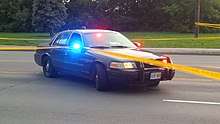
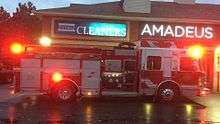
History

The use of the blue emergency light originates in Germany during World War II. As a result of the ‘Verdunkelung’, a black-out measure for aerial defense from 1935, cobalt blue was regulated to replace the red color used until 1938 in emergency vehicle lights.[1][2] Due to the scattering properties of the blue color, it is only visible to lower altitudes and is therefore less easily spotted by enemy airplanes.
Purpose
Emergency vehicle lighting is generally used to clear the right of way for emergency vehicles, or to warn approaching motorists of potential hazards, such as a vehicle that is stopped or moving slower than the rate of traffic, or a car that has been pulled over. It may also be used to provide specific directions to motorists, such as a command to pull over. Some vehicles incorporate a small arrow board to direct traffic.
The use of emergency beacons is restricted by law in many jurisdictions only for responding to an emergency, initiating a traffic stop, bona fide training exercises, or when a specific hazard exists in the road. Most private security agencies have special permits that allow them to use beacons in specific areas. It has yet to be determined whether autonomous vehicles will be required to carry lights, or what colors or patterns they might exhibit to warn off aggressive human drivers.
Optical types
The optical and mechanical characteristics of the lights (Light-emitting diode) used can have a significant effect on the look of the vehicle and how readily it gains attention in emergencies.
Steady burning
The simplest form of lighting is a steadily burning lamp. These may be white lights used on scene to enable emergency workers to see what they are doing, or they may be colored lights that advertise the emergency vehicle's presence. In the latter case, steadily burning lights are often used alongside rotating or flashing lights rather than on their own, though historically some emergency vehicles only displayed steadily burning lights. For example, California Vehicle Code Section 25252 states: “Every authorized emergency vehicle shall be equipped with at least one steady burning red warning lamp visible from at least 1,000 feet to the front of the vehicle”
Rotating light
These revolving lights may contain a single, stationary bulb around which a curved mirror is spun (or which is attached to a spinning mirror), or a lamp with a Fresnel lens. This creates rotating beam(s) of light, appearing to flash when viewed. Larger rotating lights may contain modular or sealed-beam lamps which rotate as an assembly (commonly 2 or 4 bulbs, but possibly 1 or 3).
To protect the workings of the beacon, a plastic dome often covers the assembly. These domes usually come in solid colors, but in some cases the front and back halves of the dome are different colors. Other beacons use a clear dome with colored lenses on each lamp; in the latter case, these rotating beacons are sometimes referred to colloquially as ‘gumball machines’ or sometimes ‘cherry tops’ in the case of red lights.
Rotating lights often use a quartz-halogen or conventional incandescent bulb, though some rotating beacons are now made with LEDs rather than bulbs.[3]
Rotating lights may be used in lightbars as well as in single beacons. In a modern enclosed lightbar, generally ‘V’- or diamond-shaped mirrors are provided between the lamps to give the effect of multiple flashing lights.
Strobe lights
Some emergency lighting is based on strobe lights similar to those used in flash photography. These xenon flash lamps put out a very brief but very bright flash by discharging a large current through a gas which ionizes the gas. The light produced has a somewhat bluish emission spectrum, which makes red lightbars glow a fuchsia-pink color when lit.
Strobe Lighting did provide intense light which could improve visibility, however the short duration of the individual flash made it necessary to design the electronics to issue multiple consecutive flashes before alternating with the other associated lens pair. This purportedly allowed time for the human eye and mind to key in and observe the source of the light. Since the changeover to L.E.D. lighting units, which could easily allow for longer duration illumination time, they have instead chosen to mimic what is actually a shortcoming of the strobe light, and design the L.E.D. light head to illuminate with multiple short duration flashes. It has been noted that depending on the surrounding lighting conditions and other vehicle lighting, strobe only warning lighting did not allow for the same level of perception of distance from the source that traditional light bar and incandescent flashing lights would provide, especially on dark highways and similar locations.
LED lighting
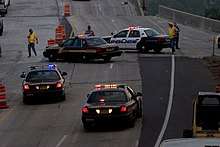
LED-based lighting is becoming very popular in the emergency services for several reasons. Light-emitting diodes are small, completely solid state, very power-efficient, long-lasting (as they have no filaments to burn out) and can be seen very easily even at great distances and in sunlight.
Whether as lightbars or single beacons, LED-based lights typically use a clear, colorless dome because the light color is an intrinsic property of the LEDs themselves. LED-based lightbars can be made very thin, reducing wind resistance by around 8-10 percent,[4] or made very flat and used in novel applications, for example to flip up under a sun visor.
LED lights are often used in a mode similar to conventional strobe lights, however they can be programmed with a wider variety of flash patterns because of their ability to be switched directly by electronics, as opposed to discharging a capacitor through a gas-filled tube.
LED lights produce relatively little heat when in use. In colder inclement climates, this has resulted in LED emergency vehicle warning lights (as well as traffic lights) being obscured by the buildup of frost or snow, raising safety concerns. Solutions are being researched to provide a heat source, as necessary in certain weather conditions, to keep LED lights clear of snow and frost.[5]
Modification of stock lighting
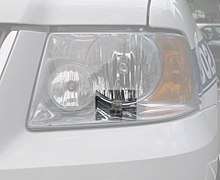
The vehicle's stock lighting may also be modified to add flashing and strobe effects. This can be done by adding electronics to the existing lighting system (for instance, to create a wig-wag), or by drilling holes in the reflectors of stock lighting and inserting flashing lights in those holes.
Information matrix signs
.jpg)
Some emergency vehicles use signs made up of a large number of light sources (usually LEDs), which can be programmed to display messages to other road users. This can be used to request other vehicles to pull over, indicate a special instruction, or just to display the name of the operating service (e.g. ‘Police’).
Mounting types
Emergency lighting may be fitted to several places on a vehicle, depending on the degree of conspicuity required. Beacons and lightbars are often mounted on the roof for high visibility, while other lights may be mounted on the body, in the grill, or in the interior of the vehicle.
Roof-mounted single beacon
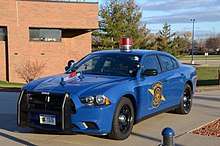
Since their introduction in 1948, rotating beacons have become widely accepted as a means of attracting attention to one's vehicle. Although the use of the single beacon in law enforcement has dropped since the introduction of light bars, they are still used by some police departments, because of their lower cost or due to tradition. One agency that continues to employ traditional red rotating beacons on its patrol cars is the Michigan State Police. Beacons are also occasionally used on construction equipment when a full-sized lightbar would be unnecessary or impractical to attach to the vehicle.
While many single beacons use rotating lamps or mirrors, others use strobe lights under a translucent dome to provide an omnidirectional flash. Some smaller and low-cost beacons of the latter type, however, are simply a blinking incandescent bulb. LEDs are also used to light some omnidirectional beacons.
The single beacon is also available with a magnetic mount for situations where permanent mounting is impractical. Examples of such situations would be detectives in unmarked vehicles, volunteer firefighters, or managers at freight yards who use an amber light for safety. These ‘mag-mount’ beacons are often round or teardrop-shaped, and are often referred to as ‘Kojak’ lights after the popular 1970s TV detective who used one.
Lightbar
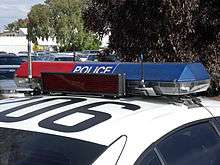
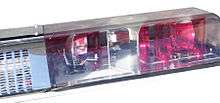
Originally, this referred to a simple metal bar on the roof of the vehicle upon which agencies would mount two rotating beacons, as well as other components such as sirens and stationary ‘lollipop’ lights. Soon the beacon manufacturers began producing off-the-shelf complete ‘lightbars’.
Later, the individual components of the lightbar were integrated into a single contiguous unit, with two elongated domes on either side of a siren enclosure. The extended domes allowed for more rotating beacons, additional mirrors, and fixed-beam lights toward the center to replace the ‘lollipops’.
Lightbars may now contain fixed, rotating, strobe, or LED-based lights in various configurations and offering programmable flash patterns. They may include a second, lower, tier of lamps, such as clear halogen ‘takedown’ lights towards the front to illuminate the vehicle being stopped, clear side-facing ‘alley’ spotlights, additional amber or red towards the rear for scene protection, or directional traffic advisory arrows. The modern trend of locating sirens on or near the front bumper of emergency vehicles has resulted in many lightbar models eliminating the siren housing in lieu of more lighting.
Some lightbar variations are specialized to meet certain desires of the agencies utilizing them, such as those using multiple rotating beacons in a ‘V’ pattern to provide additional illumination to the sides of the vehicle, and those designed to hug the roof of a vehicle to minimize air resistance or present a lower profile for ‘stealth’ purposes.
Body mounted
Some types of light can be mounted on to the outside of the vehicle (usually a permanent install) and these can be used to provide directional lighting in key areas, such as in front for clearing traffic, or to the rear for scene protection. They can also form part of the main lighting arrangement for subtly marked or unmarked vehicles. In this application, the operating service may choose to use lights with clear lenses so as to minimize the possibility of the lights being noticed when not on.
Common places to mount such beacons include on or in the grill of the vehicle and on the front of the rear view mirrors, where they can gain maximum visibility. In the UK many emergency vehicles have lights on the side of the bonnet, which helps to warn oncoming traffic when pulling out of junctions. These lights are often strobe or LED types, as they have the lowest profile for purposes of attachment.
Interior mounted
.jpg)
A variety of emergency lights may be used in the interior of a vehicle, generally on the dashboard, visor area, or rear deck. Uses range from discreet or temporary lighting for unmarked vehicles and volunteer responders, to additional rear lighting on fully marked vehicles, to a ‘slick-top’ configuration not unlike a full lightbar set.
Interior lighting is available in a variety of form factors, ranging from flat LED panels under the sun visors, to halogen or strobe lights mounted on the rear deck, to ‘cherry’ or oscillating ‘teardrop’ lights mounted on the dash. These may be permanently mounted and wired into the vehicle's electrical system, or they may be temporarily mounted and plug into the vehicle's cigarette lighter. They are often fitted with shields which direct the light through the window, but prevent reflections in to the cab.

The aerodynamic properties of light bars can be important for police applications, as fuel efficiency and drag are concerns in patrol and pursuit. Because of this, some police cars do not have roof mounted lightbars. These ‘slick-top’ cars mount their emergency lights within the cruiser, generally around the periphery of the windshield or into the leading or trailing edge of the roof. Slick-top police cars also lack the silhouette of a lightbar or beacon, making the car harder to identify as a police vehicle from a distance, especially fore and aft. Because of these visual advantages, these vehicles are sometimes referred to as ‘stealth’ vehicles.
A key disadvantage of relying solely on internal lighting is the number of lights required to achieve true 360 degree visibility, with most lights usually concentrated front and rear. This can limit the application of vehicles for instances such as scene protection.
Vehicle integral
Sometimes, the existing lighting on a vehicle is modified to create warning beacons. In the case of wig-wag lighting, this involves adding a device to alternately flash the high-beam headlights, or, in some countries, the rear fog lights. It can also involve drilling out other lights on the vehicle to add ‘hideaway’ or ‘corner strobes’.
Scientific research
Perception
A study at Loughborough University in the United Kingdom showed that strobe lighting conveyed a greater sense of urgency to other road users, with the faster the flash the greater urgency, potentially helping to speed the emergency vehicle through traffic. It also concluded that factors such as flash pattern were important, with simultaneously flashing beacons attracting attention far quicker than alternately flashing versions, although this did increase discomfort glare. In general, as light intensity and the number of beacons present increased, the time it took to gain the attention of other drivers decreased.
This same study compared different light colors for glare and detection time under both daylight and night conditions. While red and blue both compared favorably with amber for glare under various conditions, some contradictory findings were observed for detection time. When all colors were held at equal intensity, amber had the poorest detection time both daytime and night. However, when the light source was held at constant intensity, the amber filters, which generally let the most light through, had the best detection time.[6]
Potential hazards
There may be a number of hazards to other road users related to the use of emergency beacons, and these effects should be mitigated as far as possible during vehicle design. These potential hazards include:
- Photosensitive epilepsy - This is an epileptic reaction to flashing lights in susceptible persons, which can range in severity from an unusual feeling or involuntary twitch to a generalized seizure. This epileptogenic response can be triggered by lights flashing in the frequency range of 10–20 Hz, regardless of color. While individual light sources used on emergency vehicles generally have much lower flash rates than this,[7] the Loughborough study suggests that such possibilities be minimized. It also notes that emergency workers may report distraction and eyestrain unrelated to epilepsy from working under the lights.[8]
- Glare - A bright light source in a person's field of view can reduce their ability to see other objects. The effect may be exacerbated by rain, windshields, or eyeglasses. The study distinguished between ‘disability glare’, where a driver may be temporarily blinded and unable to see hazards in the road, versus ‘discomfort glare’, which is a more general effect from lights which may cause motorists to avert their eyes. The worst effects for disability glare occurred with amber beacons, strobe beacons, and especially bright lights.[6]
- Phototaxis - This is the so-called ‘moth-to-flame’ effect, where the hypothesis runs that some drivers may be so distracted by the beacons that they are ‘drawn’ to them. The Loughborough study, referencing the February 1998 issue of the U.S. trade journal Tow Times, asserts that there was a lawsuit in the U.S. where a tow operator was found liable for an accident for this reason, though the study authors were unable to locate any supporting scientific research.[9]
Usage by country
| Wikimedia Commons has media related to Police automobiles by country. |
The color of a vehicle's emergency lights is useful to denote the type of vehicle or situation, but the relationship between color and service varies widely by jurisdiction.
By far the most common colors for the core emergency services to use are blue and red, and there are some arguments for using both. One study found that for flashing lights, red was more easily perceived in daylight, and blue at night. Furthermore, red has advantages in haze and fog, while blue stands out against traffic at night.[10] On the other hand, a different study found that red had the quickest detection times at night.[11]
In most of Europe emergency vehicles use blue lights. However, it is a darker specification blue than used in other parts of the world.
Red lights are not common in Europe, though they are used in some countries where red has a specific meaning. Police in Finland, Estonia, Germany and Sweden use a forward-facing red light to indicate that a driver must pull over and stop. In the U.K., police cars are outfitted with flashing red lights to the rear which are toggled on/off separately from blue lights to indicate caution. Fire Command units are also equipped with them when being used for command duties. As are certain bye-law enforcement and a small selection of private security companies.Austria, Germany and Sweden also use red on fire vehicles to designate the command post; in other countries a single green beacon sometimes designates the command post. In Sweden, a green strobe will indicate a medical command vehicle. Greece uses red on fire engines, and red along with blue on police vehicles. In Hungary, red is used only along with blue (on right in lightbars and roof integration) by police (including military police and diplomatic escort) and ambulance. In Poland, red is used on designated vehicles, including police and military vehicles, to indicate the beginning and/or end of a convoy (of those type of vehicles). Until recently the National Police in Slovakia used only blue lights, they have recently started using red and blue lights; Municipal and Military Police used blue lights in Slovakia. In Russia and Belarus, traffic police use red and blue lights, while conventional police along with the rest of the emergency services use only blue lights.
Argentina
Argentina uses blue for police, red for fire, green for ambulances, and amber for utility vehicles.
Australia
_SV6_sedan%2C_Western_Australia_Police_(2018-09-28).jpg)

In Australia, colors are generally regulated at the state level, but there are some commonalities:
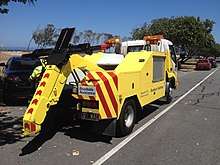
Red and blue
This is used by all State and Federal Police forces, Naval Police, Military Police, Air Force Police and Australian Border Force motor vehicles. Red and blue is also used by all State and Australian Defence Force fire and ambulance services. Civilian Ambulance and most fire units across the country use red and blue lights with State Emergency Service motor vehicles in most states being authorised to use the red and blue light combination (WA SES only fit red and blue lights to Priority One Cliff/Vertical Rescue or Road Crash Rescue vehicles, with all others having red only). New South Wales also allows red and blue to be used by Roads and Maritime Services traffic commanders and traffic response crews designated as emergency vehicles.[12]
Red
Red lights signify a risk-to-life situation,[13] and are used alone by Aviation Rescue Fire Fighting (ARFF), Mines Rescue, Western Power, Red Cross blood/organ transport, St John Ambulance Service and all WA State Emergency Service that do not have red and blue. Red lighting used to be in use for fire engines, ambulances and non WA State Emergency Service motor vehicles before they changed to red and blue.
Amber
Amber or yellow lights are used by roadside breakdown vehicles, security patrol vehicles, tow trucks, road construction/repair motor vehicles and most other utility vehicles. Amber is also used by motor vehicles operating in and around airports and docks, this includes Australian Federal Police and Australian Customs vehicles which are fitted with additional amber lighting to supplement their red and blue lightbars. Queensland State Emergency Service motor vehicles are only authorized to display amber lights under certain circumstances.
Green
These are used to denote a stationary ambulance, fire or police command motor vehicle. In Queensland it is also used on some State Forest bush fire units along with the amber. Further, in Queensland, some municipal animal control units use a green and amber light combination.
Blue
Blue lights are reserved for emergency motor vehicles in general, such as police, fire, ambulance, State Emergency Service (except Queensland) and traffic commanders. Blue by itself is also used by airport emergency vehicles to designate a command vehicle.
Magenta
Sometimes referred to as purple, magenta lights are primarily used by heavy vehicle enforcement/escort officers of the NSW Roads and Maritime Services, Victorian VicRoads and South Australian Transport Safety Inspectors. They are also used in combination with amber lights by some council rangers[14] and the New South Wales Ministry of Transport. In Western Australia magenta is used by the Department Of Environment and Conservation ‘HAZMAT Response Unit’. Magenta is also used in some Escort Vehicles used whilst escorting large mining equipment to the north of the state.
White
White lights are used on most newer emergency vehicles, both as an extra color on lightbars and in the form of ‘wig-wag’ headlights.
Many police motor vehicles, and less often other emergency services, also fit LED matrix variable message displays to vehicle lightbars. Such message bars used in New South Wales by the police and fire brigade are capable of displaying numerous messages warning motorists of various hazards or dangers.[15]
Belgium
Belgian law prohibits red lights facing forward and therefore emergency vehicles normally only use blue lights (red lights are allowed at the rear). Other agencies and authorities that are permitted to carry blue lights on their service or intervention vehicles include the customs administration, the military police, the service for the removal and destruction of explosive devices, the governors of the provinces, the civil defense service, the security service of the railroad network, Infrabel and utility companies.[16]
Brunei
Blue is used for police, red for ambulances and combination of red and blue for fire trucks. Yellow is used for buses and trucks such as pick ups and tow trucks.
Canada
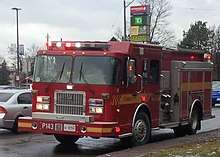
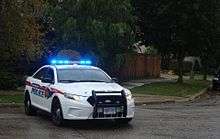

Generally, red and white are used for emergency vehicles, amber for parking/bylaw enforcement, construction, utility vehicles, Amber and White for security vehicles, and green or red for volunteer firefighters as per various Provincial legislations. Blue is used, along with red, for Police/Peace officers, as well as for snow removal vehicles in Ontario (with Amber for Municipal snow removal and amber and blue for Saskatchewan, Alberta). Purple is used for a funeral. Police now use both red and blue Canada-wide (except where local laws prohibit), including Ontario (thanks to successful testing in Toronto and Ottawa, and changes in the provincial traffic act), where the color blue was only used for non-emergency work.[17][18] Blue flashing lights are still permitted on snow removal vehicles in Ontario, as long as they are not used in conjunction with flashing red lights.[19]
Some provinces restrict municipal peace officers (the exact title varies by province) to a different color; for instance, red-only in Québec, and amber in Ontario. However, Ontario does permit certain types of provincial enforcement officers, such as Ministry of Transportation, red lights. Officers appointed to enforce the Highway Traffic Act and other statutes use red or red and blue lights as well, such as Ministry of the Environment, Ministry of Natural Resources, City of Yellowknife Municipal Enforcement Division, Iqaluit Municipal Enforcement Dept, Alberta and Saskatchewan Peace officers, University Constables and others. White flashing lights are common as a supplemental light on emergency vehicles, particularly for fire and ambulance vehicles.
In New Brunswick Green is reserved for EMO Command post.[20][21] In addition to the use of optional green lights, volunteer firefighters often receive special license plate size markings (red letters on a yellow background) to be displayed in place of a front license plate, or in the window of said vehicle.
Manitoba allows Red for Volunteer Firefighters.[22] Special personal vehicle Firefighter licence plates are also available for those Responders (and retired members) that desire them on a departmental sign-off approval basis by local Fire Departments and through Manitoba Public Insurance (MPI).
Quebec allows red for off-road vehicles used within an off-road trail by trails security officers.[23]
Utility vehicles generally use amber. Ontario and Newfoundland use blue lights for snowplows, while Alberta uses amber and red for snowplows, and has a public awareness campaign advising motorists that “flashing amber and red means snowplow ahead”.[24] Alberta also allows red lights on certain classes of utility vehicles, such as natural gas utilities which may need to disconnect a gas line in an emergency.[21]
While funeral vehicles may also use amber, more recently, some funeral vehicles in Ontario, and more recently Alberta; have begun using purple lights for identification.[25] Often, as a courtesy, motorists yield to funeral processions. However, they are not required to by law.
- Red and blue: police; and ‘other non-police law enforcement’[lower-alpha 1] in all provinces and territories.
- Red: Fire Department, Volunteer FD responders in certain Provinces (Manitoba); other non-police law enforcement in the provinces of ON and QC and search and rescue vehicles in BC.
- Red and white: Emergency Medical Services, St. John Ambulance and private ambulatory services; police services that have not changed over to Red and blue
- Blue: Public works vehicles in Newfoundland and Labrador
- Amber and blue: snow plows - Manitoba and Ontario (see TAC Snow Removal Equipment Visibility Guide - July 2015 ISBN 978-1-55187-574-3).
- Amber: construction and utility; funeral homes; airport service vehicles (excludes emergency vehicles); private snow removal vehicles (Ontario); Canadian Automobile Association Emergency Assistance vehicles; snow removal (Nova Scotia).
- Purple: funeral processions - British Columbia,[26] Ontario, Alberta, Manitoba, Nova Scotia, Newfoundland and Labrador, and Prince Edward Island.
- Green: is now being used by security agencies. It is also being used by emergency service volunteers in certain provinces (including St. John Ambulance in Ontario).[27] Green may also be used by stopped Emergency Vehicles to denote a command vehicle or the site commander, New Brunswick EMO Command post. Volunteer Fire Fighters (Ontario).
- White/clear: mall security (Ontario); university campus security (Ontario)
Colombia
Under Colombian law, emergency vehicles are authorized to use lights and sirens to demand priority in traffic. However, rather unusually, it is not specified what types of lights and sirens can be used.[28] Since emergency vehicles are usually imported from other parts of the world, one can see a great variety of light colors and siren types in Colombia. Since most law enforcement duties are consolidated in the National Police, there is some uniformity in police vehicles. Until the early 1990s, these police vehicles were equipped with yellow lights, although today they are equipped with a single red and blue LED lightbar on the roof, and sometimes supplementary red, white, and blue grille lights. Other, more minor law enforcement vehicles (Military Police, CTI, UNP) generally follow the same scheme.
Fire trucks are generally imported from the US, and therefore primarily use red lights although European-style fire trucks with blue lights can sometimes be seen and, more rarely, yellow lights as in Spain.
Like the US, ambulance service in Colombia is often contracted out to private companies, and some hospitals operate their own ambulance services. These different services outfit their vehicles differently, so there is little uniformity. Also, many ambulances are imported from other countries and retain the lighting schemes of their country of origin. Most ambulances use red or red and white light combinations. However, ambulances operated by the National Police and the Army are equipped with red and blue lights. Some ambulances can be seen with green lights, meaning they were imported from Argentina where ambulances always use green lights. Others still can be seen with yellow lights, like in Spain.
As in most of the world, utility vehicles usually use flashing yellow/amber lights.
Although only emergency and utility vehicles are allowed to display flashing colored lights, this law is usually not enforced and it is common to see private vehicles customized with colored lights. Taxis commonly display flashing blue lights as decoration, although some taxi drivers install sirens onto their vehicles in order to get around traffic. Many busetas (the traditional, unregulated bus systems in many urban areas) and chivas (rural, informal, public buses) also display colorful flashing lights.
Czech Republic
Special audible warning device (siren) supplemented with special warning in blue color can be fitted to vehicles. Specifically vehicles classified for primary emergency services (state police, professional fire brigades, emergency ambulances) can use from 2019 combination of blue and red lights. Red lights must be installed only on the left side of vehicle, whereas ratio of blue and red lights on vehicle must be 1:1. White flashing light can be used as minor supplementary color in lightbars.
- Ministry of Interior used by the police and identified by special legislation,
- the Prison Service,
- military police designated by special legislation,
- Municipal Police, which determines the municipality,
- fire departments,
- mine rescue service,
- emergency service gas facilities,
- emergency medical services and transport sick, wounded and pregnant women,
- used by the Armed Forces military rescue units for carrying out humanitarian tasks of civil protection.
- the customs administration marked by a special regulation.
Amber lights are used for non-emergency warning on many different vehicles - e.g. road construction vehicles, heavy transports, tow trucks, municipal services (dustcarts, road hoovers), ...
Other colors for flashing lights or beacons are not allowed.
France
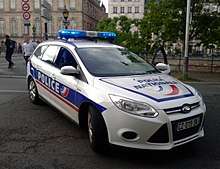
Blue
When responding, emergency vehicles (including Police cars) are required to have, at least, one -360 degrees visible- blue light on the roof. French law strictly states what kind of blue lights and sirens an emergency vehicle can display, with 2 different categories. [29]
- The first category includes Fire, local and national Police, Gendarmerie, Customs, Penitentiary service, public EMS (SAMU), private ambulances under SAMU contract and government civil defence. These vehicles must use two-tones sirens and beacons with a rotating effect, and/or lightbars with flashing or rotating effects. They can also use two additional blue, flashing, front-facing lights.
- The second category includes other private ambulances, blood/organ transport, railroad security, snow plows, highway maintenance/safety and electricity/gas units which respond to incidents and Banque de France transport trucks. These vehicles must only use three-tones sirens (except snow plows) and beacons with a flashing effect, and/or lightbars with flashing effects.
Amber
For any emergency vehicle, amber lights can be used with or without blue, to warn other drivers the emergency vehicle is stopped or slow. Non-emergency vehicles allowed to use amber include agricultural, construction, utility, oversized, tow and airport vehicles.
Green or red
These are not considered emergency lights, but are often used on the roof of command vehicles at the scene of incidents.
Germany

Only emergency and police vehicle may use blue lights. This includes firefighters, rescue services, emergency response vehicles for public utilities and civil defense units. All other kinds of blue lights (e.g. car floor lighting or cab interior lights), including reflective stickers or paintings, are illegal on public roads.[30] Flashing blue lights and sirens may only be used by authorized vehicles in case of emergency and order all other vehicles to make way, since these vehicles have the absolute right of way. Blue lights alone may be used to secure the site of an accident (or a standing emergency vehicle). Sometimes, columns of emergency or police vehicles use blue lights (without sirens) to make the column more visible to other vehicles.[31]
Blue and yellow are the only colours of flashing lights legal for use on moving vehicles. Other colours, such as red or green are sometimes used to show vehicles of special functions, such as incident command, when stationary.
German police lightbars often have ‘POLIZEI’ written in white over the dome, and usually incorporate an LED text display that can read, in mirrored writing if towards the front, ‘HALT POLIZEI’ or ‘BITTE FOLGEN’ (‘please follow’), to signal drivers to pull over. In the newest generation, the text display changes between German and English (HALT POLIZEI → STOP POLICE and BITTE FOLGEN → FOLLOW ME).
Greece
Police used to have blue-colored emergency lights but after a recent restock of vehicles, now the use of both blue and red color is usual. Fire Departments make use of red only emergency light while ambulances either use red or both colors. Regulation also states that the Military as well as vehicles carrying politicians can make use of a single rotating blue light at the roof. Every other individual and/or company may use yellow lights for either warning or emergency. Special groups like Emergency Response teams and agents may also include emergency lights on their private vehicles in case of an emergency when not in active duty. All utility vehicles such as construction related, tow trucks must be equipped with a yellow-colored emergency light bar on the top, clearly visible from the front and rear side. The same applies for private security firm vehicles, that are in generally treated like typical private cars.
Hong Kong
Under Hong Kong Law, Chapter 374G of the Road Traffic (Traffic Control) Regulations: Section 46 Giving way to animals, police vehicles, ambulances, etc., drivers must yield to vehicles which are sounding siren and/or flashing light bars.
- Red and blue: Hong Kong Police Force
- Red only: Fire Services Department fire engines
- Blue only: Ambulances, whether operated by Fire Services Department, Auxiliary Medical Services, or Hong Kong St. John Ambulance; Customs and Excise Department, Hong Kong Correctional Services
- Amber only: Utility vehicles, Civil Aid Service, all vehicles in the air-side of the airport (for pilots' visibility), Hong Kong Immigration Department vehicles
Hungary
Blue lights only
These are used by police, ambulance service, emergency blood transport, fire brigade, emergency response teams (public services), correction facilities.
Blue and red
Used on most police and ambulance, and on some types of fire vehicles, but red is to be used only in combo with blue. Ambulances usually have large integrated roof corner flash lights, 3 blue ones and 1 red at front right position, and 3-5 or more smaller red/blue flash lights on mirrors, hood, grill, side and back, mounted and used in a zig-zag pattern. Separately-mounted external lightbars on ambulances are rare, used just on doctor's cars and older vans. Police cruisers usually have a lightbar similar to that of German units (Hella 3) with red and blue lights (red on right, like on ambulances), a blue flash behind the windscreen, and additional blue flash lights in the grill. Since Dec 2017, new police lightbars feature integrated LED matrix to display messages to front (mirrored) and rear, alternatively changing text in Hungarian and English. Some police units often use additional lighting, e.g. strobe lights, alternating headlight flash, behind-windshield blue/red lights. Detachable blue flash lamps are occasionally used by unmarked cars of special police forces, by personal transport services for government members, and diplomatic convoy/escort vehicles.
Amber
Amber or yellow flashing lights and lightbars are for warning some special attribute (e.g. oversized, slow, parking at unexpected places etc.) of vehicles like garbage trucks, road cleaning/control/repair, snow plow, car assistance services, construction, transporting dangerous materials etc. Amber/yellow lights do not grant traffic privileges, except to go in the opposite direction in one-way streets or driving on the opposite side in some cases, e.g. road cleaning.
Indonesia
Under the Indonesian Legislation number 22 year of 2009 section 59 the colors and users of lightbars are:
- Blue: Indonesian National Police and escort units
- Red: Ambulance, fire brigade, and Search & Rescue units
- Amber: Tow Trucks, and Road engineer vehicles
Ireland
Blue lights
Usage of emergency vehicle lighting is restricted in Ireland through the Road Traffic Lighting of Vehicles (Blue and Amber Lamps) Regulations 2011[32]
The main colour for emergency service vehicles is overwhelmingly blue, although there is also widespread use of flashing (white) headlights, and many police vehicles have a set of two rear-facing red flashing lights to indicate that the police car is stopped or to indicate caution.
The use of blue lights not exceeding 50w are limited to vehicles being used-
- By a member of the Garda Síochána in the performance of his or her duties as such member.
- As a fire brigade vehicle.This Includes a vehicle used by senior fire officers in the performance of their duty as such officer.[33]
- By persons providing an ambulance service.
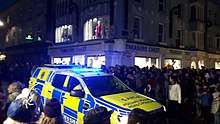 Blue lights in use on a Garda Roads Policing vehicle
Blue lights in use on a Garda Roads Policing vehicle - By the Irish Prison Service.
- As an Irish Marine Emergency Service vehicle, with or without a trailer.
- For the delivery or collection of human transplant organs human blood or human blood products.
- Marked Military Police vehicles.
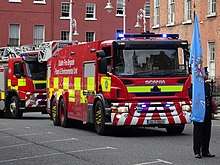
Although not specifically linked to the use of warning beacons, the police, fire brigade and ambulance services (but not the other emergency services listed above) may also choose to allow their drivers to claim legal exemptions from most motoring regulations, such as being able to treat a red traffic light as a give way sign, exceeding the speed limit, passing the wrong side of a keep left/right sign, or parking in restricted areas.[34]
No qualification other than a driving licence is legally required to use blue lights. However most organisations will insist that their drivers are trained in emergency driving techniques.In 2014[35] the Emergency Services Driving Standard was launched with the backing of all major emergency services.[36]
Amber lights
Amber lights grant no priority in traffic and exist purely to advertise the vehicle's presence.
The following vehicles may use Amber flashing lights on public roads-[37]
- Breakdown vehicles.
- Road clearance vehicles.
- Road works vehicle.
- A vehicle being used by a local authority or other person authorised by a local authority in the collection and disposal of refuse.
- A vehicle being used in the provision or maintenance of telephone services or of gas or electricity supply.
- Customs and Excise patrol vehicles.
The following vehicles must display flashing amber lights-[38]
- Agricultural Tractors (with limited exceptions)
- Self-propelled agricultural equipment
An amber flashing beacon is compulsory for any vehicle running 'Airside' on any airport. Any vehicle not so fitted, such as an ambulance responding to a medical emergency on an aircraft, has to be accompanied by one so fitted.
Japan
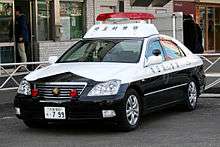
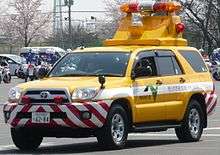
Red is the most used color on Japanese emergency vehicles. The Japanese police uses light bars mounted on a raised (mechanical) platform to make them more visible over congested streets. Rotating lights are most commonly used. But some newer vehicles have LED light bars installed. Vehicles with any other light color than red are security or engineers. Wig-wag headlights are not used.
- Red: Police, fire department, ambulance, and any other certified emergency vehicles (electric power company, gas supplier, railway company, Japanese Red Cross Society, local government, etc).
- Amber: Construction/repair/road cleaning vehicles, snow plows, highway maintenance vehicles.
- Blue: Voluntary anti-crime patrol vehicles.
- Green: Oversized vehicles and their pilot vehicles.
- Purple: Roadside breakdown vehicles.
Latvia
Almost all emergency vehicles in Latvia are equipped with roof lightbars that are:
- white with white/dark blue colour with smaller EU dark blue lights - Police (Policija), Road police (Ceļu policija)
- dark blue with smaller white lights + dark blue beacons - Paramedics (Neatliekamā medicīniskā palīdzība)
The gas emergency service (Avārijas dienests/Gāzes avārijas dienests) and the firefighter cars are equipped with the dark blue beacons on top. The gas emergency service vehicles do not have lightbars. The Police cars are the only ones that have dark blue dash flashers.
Amber lights generally designate non-emergency or slow movement vehicles such as tow trucks, tractors, combine harvesters or construction equipment.
Netherlands
The color of emergency vehicle lighting is blue. Vehicles using flashing blue lights and siren have right of way over all other vehicles. Only designated emergency/priority vehicles may use blue lights; this includes police, fire brigade, ambulance service and a few other, smaller services such as the blood bank and some lifeguard organizations. Dutch police vehicles have an LED matrix display, which can show different texts in red lighting. Most often used are STOP POLITIE (ordering a driver to pull over and stop) or VOLGEN POLITIE (ordering driver to follow the police vehicle). Standard Dutch police cars often have the text bar incorporated in the light bar, vans and motorcycles usually have a separate sign on the front of the vehicle. On ambulances, a green beacon indicates the command vehicle when multiple units are responding to an incident - usually this is the first vehicle that arrives on the scene. Newer ambulance models also have a text display that will alternate the words ‘Ambulance’ and ‘Spoed’ (‘urgent’). When ever the vehicles are on scene (usually fire brigade vehicles and some police vans), or staying in place for another reason, they need to switch to amber lighting to signal that they are not moving.
New Zealand
_01.jpg)
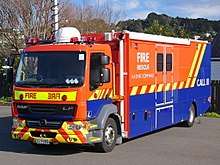
In New Zealand, the colors used on lightbars and beacons are defined by the New Zealand Transport Authority regulations.[39][40]
- Red and blue: New Zealand Police. All branches of NZ Police use red and blue warning lights. Prior to 1992 NZ Police vehicle warning lights were all blue to distinguish them from the all red lights of the Traffic enforcement Police which were part of the former New Zealand Ministry of Transport. Tunnel Control vehicles of the New Zealand Transport Agency also use red and blue lights in combination with an amber light.[41]
- Red: Used by any vehicle defined as an emergency vehicle to signify vehicles to give way to the emergency vehicle. This includes the New Zealand Fire Service, Civil Defence emergency vehicles and recognised ambulance services such as St Johns Ambulance of New Zealand, Wellington Free Ambulance, Auckland Rescue Helicopter Trust and those of the New Zealand Defence Force.
- Amber and blue: Used by customs officers, fisheries officers, marine reserve officers.
- Amber: Amber lights may be operated by towing companies, traffic management agencies,[42] construction site vehicles and heavy vehicles, or by other utility vehicles when necessary to warn other motorists of a hazard. Amber must also be fitted to oversize vehicles and their pilot vehicles.[43] Vehicles operating in airports and sea ports must display amber lights. Amber lights are permitted on Surf Life Saving rescue vehicles.[44] Enforcement employees of councils (such as Animal Control or Parking Wardens) often use vehicles fitted with amber warning lights.
- Green: Green emergency lighting is used by Registered Medical Practitioner, Registered Nurse or Registered Midwife on emergency calls. While it grants no special exemptions, drivers must give way to them.[45]
- Purple (Magenta): Load pilots escorting a load wider than 5m must display purple beacons to alert other road users there is an oversize load they may need to move out of the way for.
Volunteers in general are afforded no special privileges and cannot use flashing lights or sirens in order to navigate traffic. However, volunteer Operational Support (ex Fire Police ) members who respond to calls in their own private vehicles may be authorized by their unit or brigade to display a red beacon, for reasons of safety and identification. However, these lights may only be fitted and operational while stationary at an emergency scene, not while mobile in traffic
Norway
Emergency services in Norway use only blue lighting.[46] If a blue flashing light is seen in either traffic or the sea, other vehicles must yield to let that vehicle pass. Blue flashing lights are used by police, military police, customs, fire departments, rescue services, and ambulances. Government, VIP, and embassy vehicles may also use blue if accompanied by local police. Any vehicle equipped with a blue flashing light must have a permission issued by the DMV. The operator of such vehicle must be a qualified emergency vehicle operator and have a ‘code 160’ endorsement on their driver's license. Blue lights can be used alone or with an additional siren. The siren may not be used alone. The operator of an emergency vehicle may disregard speed limits and traffic lights with caution. Amber lights, however, are not regulated, but are used for any vehicle that need special attention, such as tow-trucks, snow plows, and parking enforcement. Red flashing lights are no longer in use, and were last used in the early 1960s.
Poland
Only designated vehicles (such as Police, Fire Service, Ambulances, Internal Affairs, etc.) are permitted to use blue light. The sale of a blue emergency light is permitted, however, the possession of such a light in vehicles (whether turned on or off, visible or not) is strictly illegal. Red lights are used by the first and last vehicle of a convoy of designated vehicles and also are strictly regulated. Amber lights are seeing increasing popularity in recent years, however, specific uses are designated according to the Polish ‘Kodeks Drogowy’. There are no specific rules governing the use of other colors such as purple, green, or clear lights.
Romania
The three emergency lights used in Romania are red, blue and amber. At a red flashing light, bringing the vehicle to a full stop is compulsory, while for a blue light yielding, slowing down and moving out of the way is compulsory, and an amber light means other traffic vehicles must proceed with caution due to an oversized or slow vehicle.
The cars that are allowed to use red lights are the Romanian Police and the Roman General Inspectorate for Emergency Situations.
Cars that are allowed to use a blue rotating light are the Romanian Police (including Local Police), Romanian Gendarmerie, Romanian Border Police, emergency medical services (including SMURD), Civil Protection, Ministry of National Defense, Special Units of the Romanian Intelligence Service, Protection and Guard Service, Ministry of Justice - General Directorate of Prisons, Public Ministry when in mission, National Anticorruption Directorate when in mission, and Financial Guard vehicles.
The amber rotating light mean the vehicle and some accompanying vehicles are oversized, overweight, transporting dangerous goods, work as road/street maintenance, are tow trucks, are tractors, or are agricultural vehicles.
Russia
- Red and blue: Traffic police (DPS Dorozhno Patrulnaya Sluzhba Road Patrol Service); FSO (Federalnaya Sluzhba Ohrany Federal Protective Service); FSB (Federalnaya Sluzhba Besopasnosti Federal Security Service)
- Blue: Police, ambulance, fire brigade, EMERCOM vehicles, gas emergency service, Central Bank of Russia vehicles.
- Amber: Construction and utility vehicles, airport service vehicles (excluding emergency vehicles), snow removal.
- White: Russian post, armored cash transport cars.
Serbia
- Blue: Police, ambulance service, fire brigade, military police, military ambulance, traffic police.
- Blue and red: First vehicle of a police vehicles convoy or military police convoy.
- Amber: Municipality police, utility and construction vehicles, heavy machines, tractors, slow vehicles.
Slovenia
- Blue: Police, ambulance service, fire brigade, military police, military ambulance, traffic police.
- Blue and Red: First vehicle of a police vehicles convoy.
- White: Additional lightbar color, wig-wag on emergency vehicles, accident scene lighting (fire and ambulance)
- Amber: Municipality police, utility and construction vehicles, heavy machines, slow vehicles.
South Korea
- Red: Fire department, Gyeongi province ambulances, some police vehicles
- Blue: Police motorcycles, some police vehicles, volunteer firefighters
- Red and blue: Police patrol cars
- Green: Ambulances (some privately operated ambulances use green and red lights)
- Yellow/amber: Utility vehicles, Security Company
Spain
The law used to allow only the Cuerpo Nacional de Policía, Guardia Civil, Policía Local and autonomous law-enforcement agencies to use blue lights, so in contrast with convention in Europe, civil defense, ambulances (Ambulancia) and fire engines (Bomberos) had to use yellow/amber lights (the only other color authorized, in contrast to convention in which these color lights are used to denote slow vehicles). Some Autonomous Communities allowed other colors, such as blue, red or white (the latter two of which is used by SAMUR in Madrid), however, these are technically illegal to use throughout Spain. In 2018 a new law finally allowed these kind of emergency vehicles to use blue lights, giving them 2 years to make the switch from yellow/amber to blue. Yellow/amber lights are now only used in wide-load trucks and their accompanying vehicles among other special vehicles, such as tractors or tow trucks. A steady burn green light is permitted on taxis available for hire, and was formerly used on buses to indicate a bus was in service and with places free for passengers.
Sweden
Blue
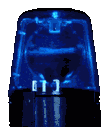
Police vehicles, medical vehicles and fire engines along with other government vehicles such as the Swedish Military Police and the Swedish Customs Service use white and dark ‘Euro blue’ emergency lights. Ordinary traffic are required to make way for these vehicles if the lights are on.
Blue lights & sirens may also be used on vehicles of that belong to private companies or organizations if their role is either life saving or protecting some vital system of society. This includes but not limited to; Medical & public transport, gas & electricity companies and security (specifically, Security Officers in charge of protecting government buildings & ports).
Amber
Amber lights grant no priority in traffic and exist purely to advertise the vehicle's presence, usually as a warning. Most commonly used on heavy machinery, trucks, bulldozers, slow-going and construction vehicles like are equipped with yellow/amber lights. It is legal to fitt these lights to other vehicles, such as privately owned cars.
Red
The Swedish police use a forward-facing red light to indicate that a driver must pull over and stop. Fire vehicles use a red light to designate the command post.
Green
Swedish ambulances use a single green flashing light to indicate the command post.
Turkey
- Red and blue: Police, gendarmerie, coast guard, military police
- Blue: Ambulance, revenue vehicles
- Red: Fire brigade, AFAD vehicles
- Amber and blue: Municipal police
- Amber: Construction and utility vehicles, gas, water and electric emergency vehicles airport service vehicles, snow removal
- Green: Funeral vehicles
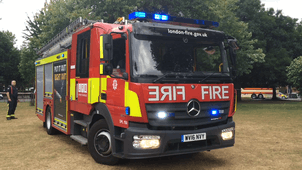
United Kingdom
Blue lights
Usage of emergency vehicle lighting is restricted in the United Kingdom through the Road Vehicle Lighting Regulations 1989.[47] It is illegal for any vehicle to show a flashing coloured light (with the exception of the normal direction indicators or a green anti-lock brake warning indicator), unless it is an emergency or other authorised vehicle.[48] However recently pedal cycles can exhibit a flashing rear red lamp and flashing white front lamp.[49]
The main colour for emergency service vehicles is overwhelmingly blue, although there is also widespread use of flashing (white) headlights, and many police vehicles have a set of two rear-facing red flashing lights to indicate that the police car is stopped or to indicate caution. The legal definition of an emergency vehicle limits the use of both methods to vehicles used for:[50]
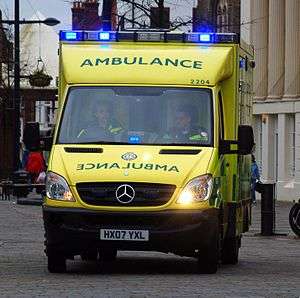
- Fire, ambulance or police purposes (this includes private ambulances and agencies who can appoint employees to the office of Constable - such as the National Crime Agency, but not private security)
- Forestry Commission or local authority when fighting fires
- Ministry of Defence bomb disposal, mountain rescue, nuclear emergency or armament support, or special forces responding to a national security emergency[51]
- National Blood Service or Scottish National Blood Transfusion Service vehicles
- HM Coastguard
- Coal Authority for mine rescue
- RNLI lifeboat launching vehicles
- Mountain Rescue
- HM Revenue and Customs when investigating serious crime.
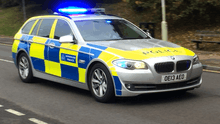
Blue flashing lights must only be lit at the scene of an emergency, or when the driver considers it desirable to indicate that the journey being undertaken is urgent,[52] and (in terms of the law) convey to other drivers that they should take special care.[53]
Although not specifically linked to the use of warning beacons, the police, fire brigade and ambulance services (and in certain cases, the blood services and bomb disposal units, but not the other emergency services listed above) may also choose to allow their drivers to claim legal exemptions from certain motoring regulations, such as being able to treat a red traffic light as a give way sign,[54] exceeding the speed limit,[55] passing the wrong side of a keep left/right sign,[56] driving in a bus lane,[57] or parking in restricted areas.[58] They may not, however, ignore ‘no entry’ signs, drive the wrong way down a one-way street or cross a solid white line in the middle of the road (other than the same exceptions granted everyone else, for example to pass a stationary vehicle). In reality some drivers will disobey other laws at their professional judgement but they do so without any automatic protection from the law.[59]
No qualification other than a driving licence is legally required to use blue lights; whilst provision has been made to require the drivers of emergency vehicles to have suitable training if they will be driving above the speed limit,[60] this has not yet been brought into force. However most organisations will insist that their drivers are trained in emergency driving techniques for the safety of all on the road. Police forces, specifically, typically have three levels of driving grade, as required by the College of Policing.[61]
- Basic - police officers are permitted to drive in accordance with their standard driving licence, obeying all traffic laws and not claiming any exemptions. Blue emergency lights may only be used when performing a stop on a vehicle or when the vehicle is stationary at a scene.
- Response - police officers are permitted to drive intermediate-powered vehicles up to approx. 200bhp, utilising blue lights and sirens for emergency response whilst claiming exemptions.
- Advanced - police officers may drive 'high-performance' vehicles of 200bhp+, utilising emergency equipment for emergency response whilst claiming exemptions. This level of training is typically offered to road policing units and armed response vehicle officers, who are expected to drive high performance vehicles in a daily capacity.
Response and advanced police drivers can be trained in 'initial phase' pursuit, which involves training in safely pursuing a vehicle under emergency driving conditions. Advanced drivers may further be trained in 'tactical phase' pursuit, which involves training in Tactical Pursuit And Containment (TPAC).
Amber lights
Amber lights grant no priority in traffic and exist purely to advertise the vehicle's presence, except when used by the DVSA or HETO which is a requirement for the vehicle to stop. The Regulations specifies several classes of vehicles which may use amber lights, such as towing, highway maintenance, pilot vehicles escorting an oversize load, and vehicles unable to travel over 25 mph[62] and fitting these lights to other vehicles(such as privately owned or pedestrian) is legal (these beacons are widely fitted to vehicles as wide-ranging as security).
An amber flashing beacon is compulsory for any vehicle running 'Airside' on any airport. Any vehicle not so fitted, such as an ambulance responding to a medical emergency on an aircraft, has to be accompanied by one so fitted.
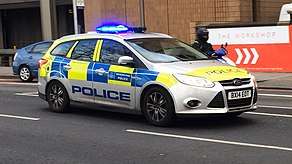
Amber lights are also used by the Driver and Vehicle Standards Agency and the Highways England Traffic Officer Service (with the addition of red lights) to stop vehicles.
Other lights
Green flashing beacons can be used by Doctors (registered with the General Medical Council) when responding to a medical emergency. Many doctors now either volunteer or are employed as First Responders for ambulance services and their vehicles will carry the, usually blue, lights used by the service or both blue and green to indicate their profession. Green lights may also be used by ambulance control vehicles, but only on scene of a major incident.[63]
Flashing red lights are fitted to the vast majority of police, fire and ambulance vehicles - being used only when the vehicle is stationary to alert other drivers of their presence. 'Rear reds' are also used during large police escorts, with the rearmost vehicle displaying red lights to alert other motorist not to pass. Hazard lights may be wired to function at the same time, to make civilians further conscious of their presence. Rear fog lights may also be used in an alternating left/right pattern. Steady checkered lights denote command and control vehicles - these are red and white for fire (one of the few situations where a forward-facing red light may be shown), blue and white for police and green and white for ambulance,[64] and are often fitted in the middle of the light bar.
It should also be noted that UK legislation considers all lights, reflectors and reflective material to be lights, and all items either being or resembling special warning beacons (of any colour), such as on preserved emergency vehicles, must be covered and not just disconnected (as this is a separate offence)[65] while on the public highway.[66] Similarly, no distinction is made between lights mounted on light bars and those mounted anywhere else on the vehicle (e.g. headlights, indicators, brake lights) - all are covered by the same regulations.
United States of America
.jpg)
In the United States, colors are generally regulated at the state and local levels, but there are some commonalities.
Red
- Almost always denotes an emergency vehicle if the lights are facing forward
- A near universal exception to this rule is school buses which are allowed to use rear and forward-facing, usually alternatively phased flashing red lights just before, during, and after passenger loading & unloading as a signal for all other traffic to stop.
- In Iowa, red lights can also be used on a funeral hearse, but only during funerals.
- In Washington State, and Texas,[67] red lights are used on tow trucks, but only if the vehicle is not in motion. Most tow trucks mount rear-facing red lights to be used in sync with the vehicle's normal stop lights.
- In Wisconsin, tow trucks are required to be equipped with red lights but such lights may be operated only when the tow truck is standing on or near the traveled portion of a highway preparatory to towing or servicing a disabled vehicle.
- In California, emergency vehicles must display at least one forward-facing steady-burn red light. Some exceptions are occasionally made for individual vehicles.
- In New York, emergency vehicles must only display red lighting to the front and sides of the vehicle, with white lighting being optional. Blue lights are only permitted to be displayed to the rear.
- In Michigan, emergency road service vehicles such as tow trucks are allowed to use red warning lights only when stationary.
- In Missouri, tow trucks and road service vehicles, volunteer firefighters and EMS may use red and blue. Electric companies may use red.
Amber or yellow
- Often used by utility vehicles such as construction vehicles, tow trucks, snow plows, funeral escorts and hearses, security patrol vehicles, postal vehicles or other vehicles which may be stopped or moving slower than the flow of traffic.
- Amber is usually the most permissively regulated color.
- In California, emergency vehicles must display at least one rearward-facing flashing amber light.(par 36)
White

- Often used as an optional color on lightbars, usually in combination with other colors to increase visibility, though it may be restricted to emergency vehicles in some states. Some lightbars include separate or integrated steady burn white lights that face forward ("takedown lights") or to the sides ("alley lights") to allow for better visibility of objects around the vehicle at night.
- White is rarely used as the only color on a lightbar, though some states[lower-alpha 2] require flashing white beacons on the rear of school buses as a rear-end collision prevention measure.
- Historically, white was used in combination with red bulb lenses in the Federal Signal Corporation Beacon Ray rotating beacon, introduced in 1948 and the later 1960s and 1970s model P A lights equipped with clear domes on through the 1980s, when revolving bulb and reflector type emergency lighting including the later 1970s Twinsonic and Aerodynic lightbars were supplanted with newer strobe types. The four bulb Beacon Ray Model 175 with a clear dome and colored lenses over the bulbs were used extensively in the 1960s by the NYPD with two red bulbs alternated with a white bulb and an amber bulb canted upwards at a 45-degree angle so the amber flash would reflect off upper-floor building windows for added traffic attention/visibility. This clear dome/colored bulb lens combination also found extensive use across the US as fire apparatus and ambulance lighting.
- Certain railroad-related machines, like fueling tankers, track maintenance and switching engines, may also use a flashing white light.
- In some states, certain government vehicles such as rural mail delivery vehicles use a flashing white beacon.
Green

- Since 9/11 green is used by Homeland Security Agencies and government/private security agencies protecting high risk government and critical infrastructure.
- Green emergency lighting is used on vehicles which are protecting nuclear facilities, oil & gas depots, water storage facilities and dams, gas pipelines, airports, defense facilities, maritime facilities, and all other areas which are at a high risk of terrorist attacks.
- Green emergency lighting is also used by private security agencies securing certain government buildings and establishments where terrorist organizations may also target. However, in the State of Florida, green is allowed for use by all private security vehicles only in combination with amber lights. (Florida state legislation is pending to also allow flashing clear/white lights in combination with amber/green security patrol lights for added visibility.)
- Green and blue emergency lighting is used by some counter-terrorism agencies whilst responding to terrorist incidents, so as to distinguish the specialist agencies from other emergency departments.
- In the Commonwealth of Puerto Rico, green and blue is used by Homeland & National Security agencies by Municipal Police Forces in addition to counter-terrorism security agencies.
- In Washington State, under the provisions of RCW 46.37.185, a firefighter may use a green light on their privately owned vehicle with the approval of the fire chief of the department they are employed by. The green light is used for identification purposes only and does not convey any special rights or status to the vehicle.
- In Oregon, and some other states, the ‘command’ vehicle at a fire scene may use a green light to identify its location.
- In Tennessee, motorcycles in funeral processions use green lights.
- In Ohio, snowplows used by the Ohio Department of Transportation use a combination of green and amber lights.
- In New York, Connecticut and Indiana, volunteer EMTs use green lights
- In New York City, a single flashing green light separated from the other red and blue flashing lights on an NYPD vehicle denotes it as a THV (Temporary Headquarters Vehicle) also known as a Mobile Command Post vehicle and also used on a 2-star Assistant Chiefs marked RMP (Radio Motor Patrol) vehicle to identify it as such.
- In Michigan, flashing or oscillating green lights denote municipal vehicles actively removing ice, snow, or other materials from roads.[68]
Blue
- Reserved for law enforcement, firefighters and EMTs.
- In New Mexico tow trucks may have blue lights in combination with amber.
- In Wisconsin tow trucks may have blue light in combination with amber.
- In Minnesota, highway maintenance vehicles display blue in combination with amber.
- In Texas, highway maintenance vehicles display blue in combination with amber.
- In California, blue lights may only be used on vehicles operated by Peace Officers, as defined under California Penal Code 830.1 to 830.38. (California Vehicle Code 25258(b))
- Alaska, Arizona, Colorado, Minnesota, and Nebraska also use blue lights on snowplows.[69][70][71]
- In New York State, forward facing blue lights are not permitted on any emergency vehicles, an anomaly in the US. The only exceptions to this is on the personal vehicles of volunteer firefighters, which are allowed to display forward facing flashing blue lights when responding to an emergency or federal emergency vehicles such as those used by Homeland Security.
- In Kentucky, civilian possession of a blue flashing light is prohibited by state law. Additionally, blue is the color used by law enforcement agencies.
- In Arkansas, civilian possession of a blue flashing light is prohibited by state law. Additionally, blue is the color used by law enforcement agencies.
- In Massachusetts, Police vehicles are only permitted to display blue lights to the front of the vehicle, with white lights being optional. Police vehicles may display to the rear at least one red light and/or amber lights. The law is inverse for fire trucks. Fire trucks are only permitted to display red lights to the front of the vehicle, but may display at least one blue and/or amber light to the rear. Ambulances usually follow the same scheme as fire trucks.
- Furthermore, the other New England states do not have legislation regulating the color of lights on emergency vehicles. They only generalize red and blue lights as being restricted to emergency vehicles. However, most police, fire, and ambulance services in these other New England states voluntarily follow the same scheme as Massachusetts.
Purple
Purple is permitted in some states to denote a funeral vehicle and /or coroner's or Medical examiner's office.[72][73][74][75]
Police
Police agencies may use red, blue, or both, depending on the state, along with white and amber as optional colors; although amber is usually restricted to face behind the vehicle. Some police cars have an amber directional control bar, also known as an ‘arrow stick’, behind the lightbar to direct traffic left or right around the vehicle; these usually have 6 or 8 rear-facing lights that flash in sequence.
Some privately operated special police are allowed to display the same colors as regular police, generally, if they receive their special police authority at the state level. This can include railroad, university, hospital, and SPCA and humane society police departments, Animal control and regulatory officers, Fish and Wildlife conservation officers and Federal and State park rangers, and Beach Safety lifeguards that are law enforcement certified.[76]
Fire and EMS

Fire and emergency medical services generally use red lights with amber and white as optional colors. Vehicles operated by fire departments, such as fire engines and heavy rescue vehicles, prominently use red, a color with strong cultural associations with the fire service, along with some amber and white. Some more modern fire trucks and airport crash units use a yellow-green color, however.
Many fire chiefs’ cars have, in addition to the red lights, a single green beacon to indicate command post status. On the other hand, in Chicago and some nearby communities, fire vehicles show a green light on the right, or starboard, side of the vehicle, reflecting nautical tradition.[77]
Emergency medical vehicles, such as ambulances and paramedic fly-cars, generally use white, amber, and red as well. Some states have a specific rule authorizing light colors for EMS vehicles, while some EMS vehicles ‘inherit’ their light colors from the fire or police department they are operated by or contracted to, and may show blue lights.
The National Fire Protection Association publishes the NFPA-1901 standards for fire vehicles,[78] which specifies the degree of lighting on various parts of the vehicles, with some flexibility as to color. There is also a GSA procurement specification for ambulances known as KKK-A-1822-F,[79] which many local authorities follow.
Volunteer Personnel
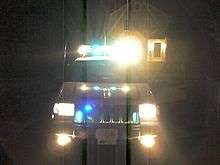
Many U.S. states allow volunteer fire, EMS and Search and Rescue personnel to place emergency warning lights in their personal vehicles for use when responding to emergencies. The degree of lighting is mandated by law and also by local custom in most areas, and can vary from a single rotating light on the dashboard or roof, to a setup much like modern police cruisers. Some states also allow volunteer use of sirens and air horns to request the right of way.
Virginia state law allows emergency personnel to equip one private vehicle “with no more than two flashing or steady-burning red or red and white combination warning lights”.[80]
In some states, volunteers are allowed to use the normal red lights, while in other states volunteers must use some other color, usually blue or green. In the latter case, the lights are used as a courtesy to ‘request’ the right of way and generally do not mandate pulling over. Some states, such as Pennsylvania, limit volunteer use of red lights to chiefs and captains of squads.
Separate colors may be used for fire versus EMS volunteers. In Connecticut, Indiana, and New York, volunteer firefighters use blue while volunteer EMTs use green. In New Jersey, volunteer fire and ambulance personnel use blue lights in their personal vehicles while responding to their stations. In NJ red lights are only allowed for emergency vehicles, fire chiefs, chief officers of first aid or rescue squads, or other law enforcement vehicles. In Iowa, volunteer firefighters can use flashing blue lights on their personal vehicles, while volunteer EMTs can use flashing white (clear) lights.
New York also certifies some volunteer EMTs to use red lights and sirens provided their vehicles carry certain equipment;[81] this is often used by Hatzolah volunteers in the NYC area. Typically in New York state, volunteer firefighters use blue lights in their personal vehicles and volunteer EMS use green lights. This may generate confusion, as green lights are also used to signify an incident command vehicle. In the state of Texas, “a private vehicle of a volunteer firefighter or a certified emergency medical services employee or volunteer when responding to a fire alarm or medical emergency” is considered an “authorized emergency vehicle” and may use alternately flashing lighting equipment or may be equipped with a siren, exhaust whistle, or bell.[82]
The conflicting color assignments can create issues for volunteers who drive their vehicles out of state. One color in their state may mean firefighter or EMT when in another state it may mean police. While some authorities may be satisfied with covering the lights with an ‘Out Of Service’ tarpaulin, compliance may be more difficult in other jurisdictions. For example, Arkansas bars civilian possession of blue lights on or in a vehicle unless sealed in the manufacturer's original package.[83]
Utility vehicles
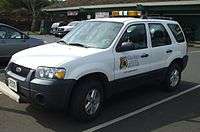
Amber lights are often used on vehicle involved in non-emergency work. Most utility companies, towing services, oversize load vehicles, slow vehicles, and certain types of construction equipment mount some type of lightbar or lighting system for a higher degree of visibility.
In Detroit, Michigan, Angels' Night volunteers will patrol neighborhoods with yellow lights to help deter vandalism during Devil's Night and Halloween. Typically these lights are the single beacon kind, although lightbars have been used for vehicles of this type, especially on wreckers/tow trucks.
In Memphis, Tennessee most city maintenance vehicles (including MLG&W utility trucks) with flashing lights use yellow lights; however, some vehicles with the traffic engineering department use red flashing lights, especially vehicles equipped with cherry pickers used to repair traffic signals.
In states that do not enforce specific rules about green, yellow or white lights, these colors are often used by entities like private security companies which may be ineligible to use blue or red lights but need emergency lights for traffic and site visibility. Security vehicles generally use their lights on private property, in addition some security vehicles are off-road only such as ATV and Golf cart type vehicles. and in most jurisdictions security vehicles are generally not allowed a ‘courtesy’ or ‘emergency’ status on public roads.
Optional colors
While certain colors are customarily used by different services, often other colors are optionally used, such as amber and white. Sometimes, this is done to satisfy particular regulations; for example, California requires a steady red light facing forward and a flashing amber light to the rear on every emergency vehicle.[84]
See also
| Wikimedia Commons has media related to Fire engines. |
| Wikimedia Commons has media related to Ambulances. |
References
- Footnotes
- ‘Other non-police law enforcement’ refers to entities such as Conservation Officers, Environmental Officers, Provincial Officers, Ministry/Department of Transportation Enforcement Officers, University Constables, Community Peace Officers, and in some cases, Municipal By-law Enforcement Officers and Fuel Tax Enforcement Officers
- Alabama, Arkansas, Rhode Island, Florida, Georgia, Illinois, Michigan, Wisconsin, Maryland, West Virginia, South Dakota, Texas, Louisiana, and Kentucky require flashing white lights on school buses
- Notes
- "Bunker in Braunschweig | Luftschutzgesetz - 8. Durchführungsverordnung". www.amaot.de. Archived from the original on 2009-11-17. Retrieved 2017-02-08.
- "1957 Light and sound signs article, German firemarshall & engineer H. Brunswig" (PDF).
- e.g. Preco’s 7600 series Archived 2009-03-08 at the Wayback Machine
- Binning, Elizabeth (11 November 2008). "Arresting image update to save police force $800,000". New Zealand Herald. Retrieved 2009-03-23.
- "Accidents: Traffic LED Light Can't Melt Snow". Findlaw. Retrieved 2010-05-02.
- Cook, Sharon; Claire Quigley; Laurence Clift (March 2000). "Motor vehicle and pedal cycle conspicuity: part 1- vehicle mounted warning beacons. Summary report.". DfT Report; PPAD 9/33/13. Loughborough University.
- Harding, Graham F.A.; Peter M. Jeavons (1994). Photosensitive Epilepsy. London: Mac Keith Press. p. 163. ISBN 1-898683-02-6.“neither car indicators nor flashing warning lights on emergency vehicles constitute a risk, of as they are restricted to 2 f/s or less”
- Cook (2000:§5.3.1)
- Cook, Sharon; Claire Quigley; Laurence Clift (June 1999). "Motor vehicle and pedal cycle conspicuity - part 3: vehicle mounted warning beacons. Final report.". DfT Report; PPAD 9/33/13. Loughborough University. p. 98.
- Wells, Jr., Lt. James D. (March 2004). "Florida Highway Patrol: Emergency Lighting Research & Prototype Evaluation" (PDF). International Association of Chiefs of Police. pp. 5, 8.
- Cook (2000:§5.1.1)
- "Vehicle Standards Information No. 4 Rev. 4.1" (PDF). 24 November 2010.
- New South Wales Roads and Traffic Authority: Flashing lights and sirens Archived 2016-02-07 at the Wayback Machine
- A council ranger is a type of peace officer found in Australia who enforces municipal ordinances, and has limited police powers.
- "flickr.com". flickr.com. Retrieved 2013-01-05.
- "regarding the technical aspects that cars, their trailers and their safety attachments must conform to". Article 28 §2, Royal Decree of March 15, 1968 (in Dutch). Retrieved October 18, 2015.
- McGuinty Government Continues To Keep Families Safe On Ontario’s Roads Archived October 11, 2007, at the Wayback Machine
- Cairns, Alan (2007-04-13). "Roof lights changing from white to blue". The Globe and Mail. Archived from the original on 2009-03-06.
- "Ontario Highway Traffic Act R.S.O. 1990: Flashing blue light on snow-removal equipment". E-laws.gov.on.ca. 2010. Retrieved 2011-05-28.
- "Ontario Regulation 484/07: Lamps — use of flashing red or green lights". E-laws.gov.on.ca. 2007-09-30. Retrieved 2010-10-09.
- "Alberta Highway Traffic Regulation 155/97". Canlii.org. Retrieved 2010-10-09.
- As per Section 38.1(4) & 38.1(5) of the Manitoba Highway Traffic Act, 1996.
- "ACT RESPECTING OFF-HIGHWAY VEHICLES".
- Alberta Infrastructure and Transportation - Snowplows
- McKenzie, Grant (July 2000). "How Safe are Funeral Processions?". TheFuneralDirectory.com.
- "Authorization to Equip Hearses and Official Funeral Vehicles with a Flashing Purple Lighting Device" (PDF). Retrieved 2013-01-05.
- "AO. Reg. 484/07: LAMPS - USE OF FLASHING RED, GREEN OR BLUE LIGHTS".
- "Concepto_0206.pdf".
- "Arrêté du 30 octobre 1987 relatif aux dispositifs spéciaux de signalisation des véhicules d'intervention urgente". Legifrance. 2004-12-23. Retrieved 2018-06-27.
- §52 Abs 3 Straßenverkehrszulassungsordnung
- §38 Straßenverkehrsordnung
- Road Traffic (Lighting of Vehicles) (Blue and Amber Lamps) Regulations 2011, Government of Ireland, 2011, retrieved 2020-03-31
- "FAQs on Flashing Lights on Vehicles" (PDF).
- "Part 5 Section 87", ROAD TRAFFIC ACT 2010, Government of Ireland (NB: police, fire brigade, ambulance)
- "Almost 2,400 emergency service drivers certified to higher driving standard since 2014". 2019. Retrieved 2020-03-31.
- "Emergency Services Driving Standard". 2019. Retrieved 2020-03-31.
- Road Traffic (Lighting of Vehicles) (Blue and Amber Lamps) Regulations 2006, Government of Ireland, 2006, retrieved 2020-03-31
- "FAQs on Lighting and Visibility on Agricultural Vehicles" (PDF). 2019. Retrieved 2020-03-31.
- "Land Transport NZ: Vehicle Lighting 2004, Rule 32005". Landtransport.govt.nz. Retrieved 2010-10-09.
- "Land Transport NZ: 2004 summary". Ltsa.govt.nz. Retrieved 2010-10-09.
- "Other Emergency Vehicles". 111emergency.co.nz. 2011-12-20. Retrieved 2018-06-27.
- In New Zealand, a traffic management agency provides civilian flaggers to direct traffic at road construction sites.
- "Driving overdimension vehicles | NZ Transport Agency". Nzta.govt.nz. Retrieved 2018-06-27.
- "New fleet of utes for Piha surf lifesavers | 1 NEWS NOW". TVNZ. Retrieved 2018-06-27.
- "The official New Zealand road code - About driving". www.nzta.govt.nz. Retrieved 7 January 2019.
- "Forskrift om kjørende og gående trafikk (trafikkregler) - Lovdata". Lovdata.no. Retrieved 2018-06-27.
- "The Road Vehicles Lighting Regulations 1989 (Statutory Instrument 1989/1796)". Office of Public Sector Information. 1989. Retrieved 2008-02-16.
- "Regulation 13 (Lamps to Show a Steady Light) of the Road Vehicles Lighting Regulations 1989". OPSI. Retrieved 2008-12-16.
- The Road Vehicles Lighting (Amendment) Regulations 2005 Reg 6
- Definition of ‘Emergency vehicle’ in Regulation 3 of "The Road Vehicles Lighting Regulations 1989". HMSO. Later additions and amendments in Regulation 3 of The Road Vehicles Lighting (Amendment) Regulations 2005 and Regulation 3 of The Road Vehicles Lighting and Goods Vehicles (Plating and Testing) (Amendment) Regulations 2009
- "The Road Traffic Exemptions (Special Forces) (Variation and Amendment) Regulations 2011". 23 March 2011. Retrieved 15 April 2011.
- "Regulation 27 (line 6 of the table) of The Road Vehicles Lighting Regulations 1989".
- "Regulation 54", The Traffic Signs Regulations and General Directions 2002, UK Statute Law Database
- "Schedule 14 Part 1 Para. 5(b)", The Traffic Signs Regulations and General Directions 2016, UK Statute Law Database (NB: police, fire brigade, ambulance, bomb disposal, and blood service vehicles only)
- "Section 87", The Road Traffic Regulation Act 1984, UK Statute Law Database (NB: police, fire brigade and ambulance vehicles only. Not, apparently, bomb disposal or blood service vehicles.)
- "Schedule 3 Part 4 Para. 3", The Traffic Signs Regulations and General Directions 2016, UK Statute Law Database (NB: police, fire brigade, ambulance, bomb disposal, and blood service vehicles only)
- "Schedule 19, paragraph 4", The Traffic Signs Regulations and General Directions 2002, UK Statute Law Database (NB: police, fire brigade and ambulance vehicles only. Not, apparently, bomb disposal or blood service vehicles.)
- “Regulations 26(5)(b) and 27(3)(c)”, The Traffic Signs Regulations and General Directions 2002 (NB: police, fire brigade and ambulance vehicles only. Not, apparently, bomb disposal or blood service vehicles.)
- Picton, Stephen. "Blues & Phews!" (PDF). Driving magazine. Croydon: Safety House (July/August 2006): 15. “In fact he has only three legal exemptions, and these with caveats: he can exceed the speed limit, if proved necessary (but can still technically be prosecuted for dangerous driving or for driving without due care and attention); he can go through a red light, on the understanding that it is treated in the same way as a Give Way or Stop sign; and he can go to the wrong side of a keep left/right sign.”
- Section 87 (Prospective Version) of the Road Traffic Regulation Act 1984 as inserted by section 19 of the Road Safety Act 2006
- "Police driving". www.app.college.police.uk. Retrieved 2020-05-22.
- "Regulation 11(2)(l) of The Road Vehicles Lighting Regulations 1989". 1989. Retrieved 2008-03-02.
- "Regulation 11(2)(m) of The Road Vehicles Lighting Regulations 1989". 1989. Retrieved 2008-03-02.
- "Regulation 11(2)(h)-(j) of The Road Vehicles Lighting Regulations 1989". 1989. Retrieved 2008-03-02.
- "Regulation 23 of The Road Vehicles Lighting Regulations 1989". 1989. Retrieved 2008-03-02.
- "Regulation 16 of The Road Vehicles Lighting Regulations 1989". 1989. Retrieved 2008-03-02.
- "Tow Truck Light Requirements and the Move -Over Law". Archived from the original on 2017-04-25. Retrieved 2016-12-31.
- "Michigan Legislature - Section 257.698". www.legislature.mi.gov. Retrieved 2019-01-30.
- Alaska Code §11.13.04.100: Flashing blue lights on vehicles Archived May 4, 2006, at the Wayback Machine
- Stidger, Ruth W. "Safer Winter Maintenance". Better Roads Magazine. James Informational Media, Des Plaines (October 2003). Archived from the original on 2007-09-27.
- "Nebraska Code § 60-6,230: Lights; rotating or flashing; colored lights; when permitted". Law.justia.com. Retrieved 2010-10-09.
- "LED Purple Funeral Lights". Prestigeemergencylights.com. Retrieved 2018-06-27.
- "Florida Statute 316.1974: Funeral procession right-of-way and liability". Flsenate.gov. Retrieved 2010-10-09.
- "Code of Virginia §46.2-1025: Flashing amber, purple, or green warning lights". Leg1.state.va.us. Retrieved 2010-10-09.
- West Virginia Code §17C-15-19. Additional lighting equipment. Archived September 29, 2007, at the Wayback Machine
- jag9889 No real name given (2008-06-30). "ASPCA Police car". Flickr.com. Retrieved 2010-10-09.
- "Why does the Chicago Fire Department outfit their trucks and stations with green lights?". Hot Times newsletter. University Park, IL: Federal Signal Corporation. June 2007. Archived from the original on 2007-11-09.
- "NFPA 1901: Standard for Automotive Fire Apparatus". Nfpa.org. 2008-10-28. Retrieved 2010-10-09.
- "GSA Automotive: Federal Vehicles Standards". Apps.fss.gsa.gov. Archived from the original on 2010-10-07. Retrieved 2010-10-09.
- "Virginia Personal Emergency Vehicle Lights". Uclue.com. Retrieved 2010-10-09.
- "NYS Department of Health: Authorizing Private Vehicles as EASV's (Use of Red Lights & Sirens)". Health.state.ny.us. Retrieved 2010-10-09.
- "Texas Department of Public Safety: Red, White, or Blue Lights". Retrieved 2015-01-20.
- Arkansas Motor Vehicle and Traffic Laws § 27-36-301: Violations Archived June 24, 2008, at the Wayback Machine
- "CA Vehicle Code §25252: Warning Lamps on Authorized Emergency Vehicles". Dmv.ca.gov. Retrieved 2010-10-09.